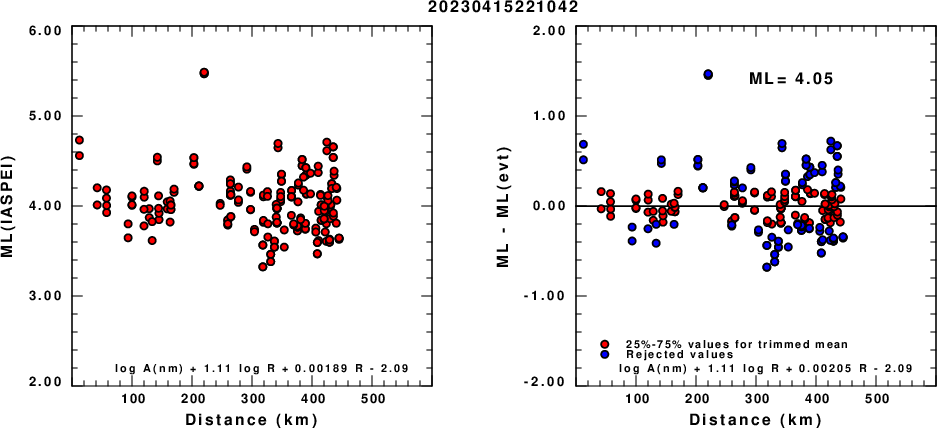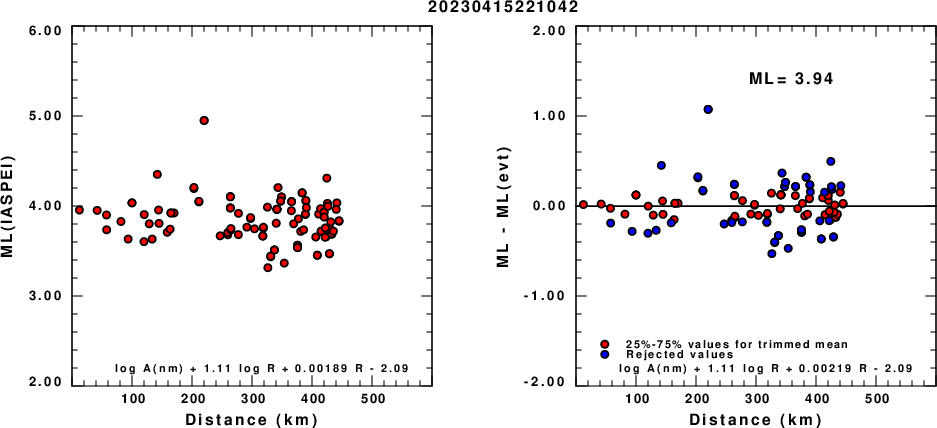Location
Location ANSS
2023/04/15 22:10:42 45.03 18.38 10.0 4.4 Bosnia
Focal Mechanism
USGS/SLU Moment Tensor Solution
ENS 2023/04/15 22:10:42:3 45.03 18.38 10.0 4.4 Bosnia
Stations used:
AC.BCI BS.BLKB CZ.JAVC HU.BEHE HU.BUD HU.EGYH HU.KOVH
HU.MORH HU.SOP HU.TIH IV.SGRT IV.TREM MN.BLY MN.DIVS MN.PDG
MN.TIR MN.TRI NI.DST2 NI.VINO OE.ARSA OE.CONA OE.CSNA
OE.MOA OE.RONA OE.SOKA OE.VIE OX.ACOM OX.DRE OX.MPRI
OX.PRED OX.SABO RO.BANR RO.BZS RO.GZR RO.LOT RO.RMGR RO.SRE
RO.SURR SK.MODS Y5.BH02A Y5.BH06A Y5.BH08A Y5.BH09A
Y5.BH10A Y5.BH11A Y5.BH12A Y5.BH13A Y5.BH16A Y5.BH18A
Y5.BH20A
Filtering commands used:
cut o DIST/3.3 -40 o DIST/3.3 +50
rtr
taper w 0.1
hp c 0.03 n 3
lp c 0.10 n 3
Best Fitting Double Couple
Mo = 8.91e+21 dyne-cm
Mw = 3.90
Z = 10 km
Plane Strike Dip Rake
NP1 154 76 154
NP2 250 65 15
Principal Axes:
Axis Value Plunge Azimuth
T 8.91e+21 28 110
N 0.00e+00 61 308
P -8.91e+21 8 204
Moment Tensor: (dyne-cm)
Component Value
Mxx -6.58e+21
Mxy -5.41e+21
Mxz -1.49e+20
Myy 4.81e+21
Myz 3.93e+21
Mzz 1.77e+21
--------------
##--------------------
#####-----------------------
######------------------------
#########-------------------------
##########--------------------------
############---------------#######----
#############------#####################
##############-#########################
############----##########################
#########--------#########################
#######-----------########################
#####--------------############### #####
##-----------------############## T ####
#-------------------############# ####
--------------------##################
--------------------################
--------------------##############
--------------------##########
----- ------------########
-- P --------------###
-------------
Global CMT Convention Moment Tensor:
R T P
1.77e+21 -1.49e+20 -3.93e+21
-1.49e+20 -6.58e+21 5.41e+21
-3.93e+21 5.41e+21 4.81e+21
Details of the solution is found at
http://www.eas.slu.edu/eqc/eqc_mt/MECH.NA/20230415221042/index.html
|
Preferred Solution
The preferred solution from an analysis of the surface-wave spectral amplitude radiation pattern, waveform inversion and first motion observations is
STK = 250
DIP = 65
RAKE = 15
MW = 3.90
HS = 10.0
The NDK file is 20230415221042.ndk
The waveform inversion is preferred.
Moment Tensor Comparison
The following compares this source inversion to others
| WVFGRD |
USGS/SLU Moment Tensor Solution
ENS 2023/04/15 22:10:42:3 45.03 18.38 10.0 4.4 Bosnia
Stations used:
AC.BCI BS.BLKB CZ.JAVC HU.BEHE HU.BUD HU.EGYH HU.KOVH
HU.MORH HU.SOP HU.TIH IV.SGRT IV.TREM MN.BLY MN.DIVS MN.PDG
MN.TIR MN.TRI NI.DST2 NI.VINO OE.ARSA OE.CONA OE.CSNA
OE.MOA OE.RONA OE.SOKA OE.VIE OX.ACOM OX.DRE OX.MPRI
OX.PRED OX.SABO RO.BANR RO.BZS RO.GZR RO.LOT RO.RMGR RO.SRE
RO.SURR SK.MODS Y5.BH02A Y5.BH06A Y5.BH08A Y5.BH09A
Y5.BH10A Y5.BH11A Y5.BH12A Y5.BH13A Y5.BH16A Y5.BH18A
Y5.BH20A
Filtering commands used:
cut o DIST/3.3 -40 o DIST/3.3 +50
rtr
taper w 0.1
hp c 0.03 n 3
lp c 0.10 n 3
Best Fitting Double Couple
Mo = 8.91e+21 dyne-cm
Mw = 3.90
Z = 10 km
Plane Strike Dip Rake
NP1 154 76 154
NP2 250 65 15
Principal Axes:
Axis Value Plunge Azimuth
T 8.91e+21 28 110
N 0.00e+00 61 308
P -8.91e+21 8 204
Moment Tensor: (dyne-cm)
Component Value
Mxx -6.58e+21
Mxy -5.41e+21
Mxz -1.49e+20
Myy 4.81e+21
Myz 3.93e+21
Mzz 1.77e+21
--------------
##--------------------
#####-----------------------
######------------------------
#########-------------------------
##########--------------------------
############---------------#######----
#############------#####################
##############-#########################
############----##########################
#########--------#########################
#######-----------########################
#####--------------############### #####
##-----------------############## T ####
#-------------------############# ####
--------------------##################
--------------------################
--------------------##############
--------------------##########
----- ------------########
-- P --------------###
-------------
Global CMT Convention Moment Tensor:
R T P
1.77e+21 -1.49e+20 -3.93e+21
-1.49e+20 -6.58e+21 5.41e+21
-3.93e+21 5.41e+21 4.81e+21
Details of the solution is found at
http://www.eas.slu.edu/eqc/eqc_mt/MECH.NA/20230415221042/index.html
|
Magnitudes
ML Magnitude

(a) ML computed using the IASPEI formula for Horizontal components; (b) ML residuals computed using a modified IASPEI formula that accounts for path specific attenuation; the values used for the trimmed mean are indicated. The ML relation used for each figure is given at the bottom of each plot.

(a) ML computed using the IASPEI formula for Vertical components (research); (b) ML residuals computed using a modified IASPEI formula that accounts for path specific attenuation; the values used for the trimmed mean are indicated. The ML relation used for each figure is given at the bottom of each plot.
Context
The next figure presents the focal mechanism for this earthquake (red) in the context of other events (blue) in the SLU Moment Tensor Catalog which are within ± 0.5 degrees of the new event. This comparison is shown in the left panel of the figure. The right panel shows the inferred direction of maximum compressive stress and the type of faulting (green is strike-slip, red is normal, blue is thrust; oblique is shown by a combination of colors).
Waveform Inversion using wvfgrd96
The focal mechanism was determined using broadband seismic waveforms. The location of the event and the
and stations used for the waveform inversion are shown in the next figure.

|
|
Location of broadband stations used for waveform inversion
|
The program wvfgrd96 was used with good traces observed at short distance to determine the focal mechanism, depth and seismic moment. This technique requires a high quality signal and well determined velocity model for the Green functions. To the extent that these are the quality data, this type of mechanism should be preferred over the radiation pattern technique which requires the separate step of defining the pressure and tension quadrants and the correct strike.
The observed and predicted traces are filtered using the following gsac commands:
cut o DIST/3.3 -40 o DIST/3.3 +50
rtr
taper w 0.1
hp c 0.03 n 3
lp c 0.10 n 3
The results of this grid search are as follow:
DEPTH STK DIP RAKE MW FIT
WVFGRD96 1.0 240 75 -10 3.46 0.2682
WVFGRD96 2.0 240 60 -15 3.62 0.3404
WVFGRD96 3.0 240 50 -15 3.69 0.3761
WVFGRD96 4.0 245 55 0 3.71 0.4076
WVFGRD96 5.0 245 60 5 3.74 0.4339
WVFGRD96 6.0 250 60 15 3.77 0.4558
WVFGRD96 7.0 250 65 15 3.80 0.4753
WVFGRD96 8.0 250 60 15 3.86 0.4915
WVFGRD96 9.0 250 65 15 3.88 0.4991
WVFGRD96 10.0 250 65 15 3.90 0.5037
WVFGRD96 11.0 250 65 15 3.92 0.5030
WVFGRD96 12.0 250 65 10 3.93 0.4987
WVFGRD96 13.0 250 70 10 3.95 0.4918
WVFGRD96 14.0 250 70 10 3.96 0.4820
WVFGRD96 15.0 250 70 10 3.97 0.4698
WVFGRD96 16.0 250 70 5 3.98 0.4555
WVFGRD96 17.0 250 70 5 3.99 0.4396
WVFGRD96 18.0 250 70 5 4.00 0.4217
WVFGRD96 19.0 250 70 5 4.01 0.4026
WVFGRD96 20.0 250 70 5 4.01 0.3832
WVFGRD96 21.0 250 70 0 4.02 0.3643
WVFGRD96 22.0 250 70 0 4.02 0.3462
WVFGRD96 23.0 250 70 5 4.02 0.3293
WVFGRD96 24.0 70 70 10 4.02 0.3156
WVFGRD96 25.0 160 85 -25 4.02 0.3101
WVFGRD96 26.0 160 85 -25 4.03 0.3086
WVFGRD96 27.0 160 85 -25 4.04 0.3066
WVFGRD96 28.0 160 85 -25 4.04 0.3032
WVFGRD96 29.0 340 90 25 4.05 0.2971
The best solution is
WVFGRD96 10.0 250 65 15 3.90 0.5037
The mechanism correspond to the best fit is

|
|
Figure 1. Waveform inversion focal mechanism
|
The best fit as a function of depth is given in the following figure:

|
|
Figure 2. Depth sensitivity for waveform mechanism
|
The comparison of the observed and predicted waveforms is given in the next figure. The red traces are the observed and the blue are the predicted.
Each observed-predicted component is plotted to the same scale and peak amplitudes are indicated by the numbers to the left of each trace. A pair of numbers is given in black at the right of each predicted traces. The upper number it the time shift required for maximum correlation between the observed and predicted traces. This time shift is required because the synthetics are not computed at exactly the same distance as the observed and because the velocity model used in the predictions may not be perfect.
A positive time shift indicates that the prediction is too fast and should be delayed to match the observed trace (shift to the right in this figure). A negative value indicates that the prediction is too slow. The lower number gives the percentage of variance reduction to characterize the individual goodness of fit (100% indicates a perfect fit).
The bandpass filter used in the processing and for the display was
cut o DIST/3.3 -40 o DIST/3.3 +50
rtr
taper w 0.1
hp c 0.03 n 3
lp c 0.10 n 3

|
|
Figure 3. Waveform comparison for selected depth. Red: observed; Blue - predicted. The time shift with respect to the model prediction is indicated. The percent of fit is also indicated. The time scale is based on the last trace plotted. It is not used to represent travel time or absolute time, but rather to indicate the number of seconds plotted. If there is not a trace directly above the scale, then a default, meaningless scale is plotted.
|

|
|
Focal mechanism sensitivity at the preferred depth. The red color indicates a very good fit to thewavefroms.
Each solution is plotted as a vector at a given value of strike and dip with the angle of the vector representing the rake angle, measured, with respect to the upward vertical (N) in the figure.
|
A check on the assumed source location is possible by looking at the time shifts between the observed and predicted traces. The time shifts for waveform matching arise for several reasons:
- The origin time and epicentral distance are incorrect
- The velocity model used for the inversion is incorrect
- The velocity model used to define the P-arrival time is not the
same as the velocity model used for the waveform inversion
(assuming that the initial trace alignment is based on the
P arrival time)
Assuming only a mislocation, the time shifts are fit to a functional form:
Time_shift = A + B cos Azimuth + C Sin Azimuth
The time shifts for this inversion lead to the next figure:

The derived shift in origin time and epicentral coordinates are given at the bottom of the figure.
Discussion
Acknowledgements
Thanks also to the many seismic network operators whose dedication make this effort possible: University of Nevada Reno, University of Alaska, University of Washington, Oregon State University, University of Utah, Montana Bureau of Mines, UC Berkely, Caltech, UC San Diego, Saint Louis University, University of Memphis, Lamont Doherty Earth Observatory, the Oklahoma Geological Survey, TexNet, the Iris stations, the Transportable Array of EarthScope and other networks.
Velocity Model
The WUS.model used for the waveform synthetic seismograms and for the surface wave eigenfunctions and dispersion is as follows:
MODEL.01
Model after 8 iterations
ISOTROPIC
KGS
FLAT EARTH
1-D
CONSTANT VELOCITY
LINE08
LINE09
LINE10
LINE11
H(KM) VP(KM/S) VS(KM/S) RHO(GM/CC) QP QS ETAP ETAS FREFP FREFS
1.9000 3.4065 2.0089 2.2150 0.302E-02 0.679E-02 0.00 0.00 1.00 1.00
6.1000 5.5445 3.2953 2.6089 0.349E-02 0.784E-02 0.00 0.00 1.00 1.00
13.0000 6.2708 3.7396 2.7812 0.212E-02 0.476E-02 0.00 0.00 1.00 1.00
19.0000 6.4075 3.7680 2.8223 0.111E-02 0.249E-02 0.00 0.00 1.00 1.00
0.0000 7.9000 4.6200 3.2760 0.164E-10 0.370E-10 0.00 0.00 1.00 1.00
Quality Control
Here we tabulate the reasons for not using certain digital data sets
The following stations did not have a valid response files:
Last Changed Sat May 6 17:21:31 CDT 2023








